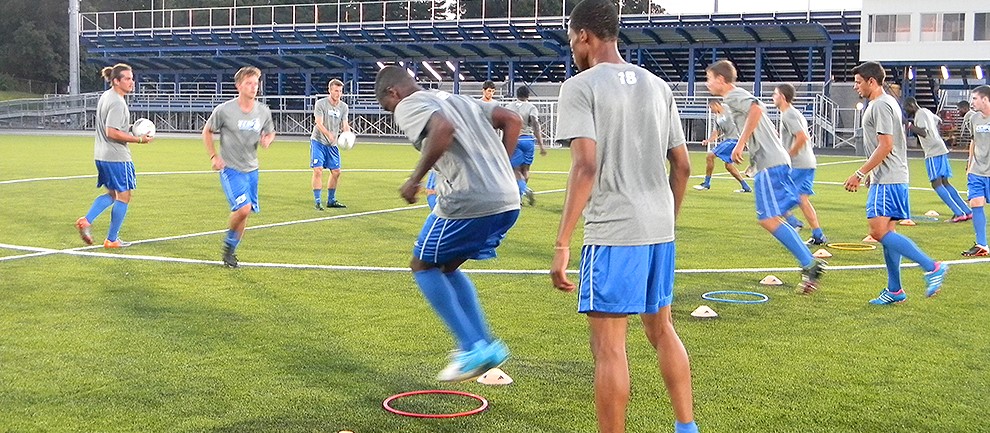Soccer is a highly demanding sport that requires strength, speed, endurance, skill, and tactical awareness. It does not matter whether you are a youth player aspiring for entry into a competitive team or an adult athlete trying to gear up for optimum performance; a soccer training program set in stone is instrumental to unlocking your full potential. A targeted plan can literally facilitate the improvement of one’s physical abilities, sharpen his/her technical skills, and maintain a potential injury-free career.
In this guide, we will elucidate how to develop an elite soccer training program capable of conjuring strong high-performance on the field.
Understanding the Requirements for Soccer Players
Before drawing up a soccer training program, it is imperative to understand, render, and define the requirements or on-field demands of the sport. These include:
- Aerobic Fitness: Players cover several miles in each match; this calls for stamina and cardiovascular endurance.
- Anaerobic Power: Various explosive sprints, jumps, and rapid changes in direction are key.
- Strength: Core strengthening of the lower and upper body will not only enhance these aspects but also balance, stability, and tackling ability.
- Flexibility and Mobility: Decreasing chances of injury; allows fluid movement.
- Technical Skills: Important aspects include ball control, dribbling, passing, and shooting.
- Mental Toughness: In decision-making, focusing, and bouncing back to normal in case of a loss, all of those are critical at elite levels.
In so doing, one can build a soccer training program targeting all aspects of performance.
Key Components of a Soccer Training Program
1. Warm-Up and Mobilization
Every session should start with an active warm-up to increase blood flow, activate muscles, and prepare joints for movement. This can include the following exercises:
- High knees, butt kicks, lunges.
- Active stretches for hamstrings, quads, and hip flexors.
- Agility ladders for footwork improvement.
2. Strength Training
Strength training is the backbone of an elite soccer training program. Emphasis should be placed on compound movements that develop lower body, core, and upper body strength:
- Legs and glutes: squats and lunges.
- Posterior chain: deadlifts.
- Core stability: planks, Russian twists, medicine ball stuff.
- Upper body endurance: push-ups and pull-ups.
3. Endurance and Condition
Soccer is played for 90 minutes at a steady effort. Aerobic and anaerobic conditioning should be used side by side:
- Interval sprints for explosive power.
- Long-distance runs for aerobic base.
- Sprints/hill runs for stamina.
4. Technical Skills
Incorporate ball work into every session to hone technique:
- Passing drills for accuracy and speed.
- Dribbling with cones to improve agility.
- Shooting from varying angles and distances.
5. Tactical Awareness
Players must think tactically while on the pitch, so include exercises that mimic game conditions:
- Small-sided games for improved positioning and decision-making.
- Set-piece practice for free kicks, corners, and penalties.
- Video-analysis sessions to study opponents and improve situational awareness.
6. Recovery and Injury Prevention
Recovery is vital for anything pertaining to performance. Add stretching, foam roller routines, and rehydration strategies. Days off from aerobics are another way to help maintain fitness levels.
How to Easily Design an Elite Soccer Training Program
- Individualize the plan: Players differ in strengths, weaknesses, and positions. Hence, from the exercise standpoint, they need special needs.
- Progressive overload: Gradually increase intensity and volume to prevent stagnation.
- Track performance: Track various metrics such as sprint time, strength gains, and skill accuracy to measure improvements.
- Balance training and rest: Overloading may lead to fatigue and possible injuries; thus, it is critical to include active recovery and rest days.
- Set Aside Time for Mental Conditioning: Reinforcement of visualization, mindfulness, and focus drills on game day will help in performing well on that day.
Model Weekly Schedule for Elite Soccer Training
- Monday: Strength training (lower body focus) + technical ball drills.
- Tuesday: Endurance training + small-sided games.
- Wednesday: Recovery (light stretching, yoga, or mobility work).
- Thursday: Strength training (upper body/core) + tactical drills.
- Friday: Interval sprints + shooting practice.
- Saturday: Full match simulation or competitive scrimmage.
- Sunday: Rest or light recovery session.
Benefits of a Structured Soccer Training Program
Well-thought-out soccer training almost guarantees measurable results:
- Speed, agility, and strength enhancement.
- Ball control and technical skill enhancement.
- Increased endurance and stamina to last through performance.
- Diminished risk of injury via proper conditioning and recovery.
- Stanched confidence and mental toughness while on the field.
Elite soccer training fosters the maximum realization of a player’s potential while sustaining physical health and performance for the long term.
Conclusion
Soccer is way beyond running and kicking a ball; it is a sophisticated sport that requires strength, skill, and strategy. A structured soccer training program enables players to develop all necessary components while minimizing injury risks. By integrating strength, endurance, technical skills, and recovery into your routine, you can make an eminent performance and select yourself amongst the highest competition. Be it as a little junior, an amateur, or a professional, the design of your very own elite soccer training program, custom-fit to your goals, will steer you into being an excellent player on the field. Set up, consistency, and smart plans keep attached with a dedicated effort; only then will you see the elevation of your game and a performance ship-shape to every match.
